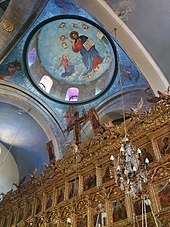Pano Lefkara
The museum is located in a restored house and exhibits the furniture and effects of a wealthy family, local costumes and examples of the Lefkara lacework.According to legend, Leonardo da Vinci visited the village in 1481, and purchased a lace cloth for the main altar of the Duomo di Milano.The bare stone façades with few openings, the layout of rooms around an inner courtyard and the flat rammed-earth roofs are typical elements of the architecture of Pano Lefkara until the late 19th century.Starting in the early 20th century, the commercialisation of local embroidery sold all over Europe by the people of Pano Lefkara produced major changes.Dating from this period are the two-storey houses with shops on their ground floors, sloping ceramic tiled roofs and long balconies running the length of main façades rendered in coloured plaster and decorated with period neoclassical architectural elements.21 nil World War II interrupted the sale of embroidery, which never recovered.The shortage of work forced inhabitants to emigrate en masse and in the 1930s half of the village of Pano Lefkara was left uninhabited.




MunicipalityCountryCyprusDistrictLarnaca DistrictSophocles SophocleousTime zonePostal codelefkaritikahandicraftsTroödos MountainsNicosiaLimassolLefkara lacework.legendLeonardo da VinciDuomo di MilanoNeolithicSaint NeophytosKato DrysByzantine EmpireFrankishVenetianfiefdomcourtyardembroideryEuropeneoclassicalWorld War IIGreek CypriotsTurkish CypriotsKofinouintercommunal violenceNorthern CyprusTurkish invasion of CyprusAgios TheodorosList of twin towns and sister cities in EuropetwinnedRafinaLusignan, VienneHouse of LusignanKingdom of CyprusThe Daily TelegraphNicosia DistrictAglandjiaAgios DometiosEngomiKythreaLakatamiaLatsiaMorphouStrovolosLimassol DistrictAgios AthanasiosGermasogeiaKato PolemidiaMesa GeitoniaYpsonasAradippouAthienouDromolaxiaMeneouLarnacaLivadiaFamagusta DistrictAyia NapaAkanthouDeryneiaFamagustaLefkonikoParalimniSotiraPaphos DistrictGeroskipouPaphosPegeiaPolis ChrysochousKyrenia DistrictKaravasKyreniaLapithosDromolaxia–MeneouAgia AnnaAgioi VavatsiniasAlaminosAlethrikoAnafotiaAnglisidesAplantaAvdelleroChoirokoitiaDelikiposGoşşiKalavasosKalo ChorioKato LefkaraKelliaKivisiliKlavdiaKornosLageiaMaroniMazotosMeliniMelouseiaMenogeiaMosfilotiOrmideiaOrokliniPergamosPervoliaPetrofaniPsematismenosPsevdasSkarinouSoftadesTersefanouTochniTremetousiaTroulloiVavatsiniaXylofagouXylotymbou